How to build a website like eBay
eBay is the world's second-most visited marketplace. Here are the 10 steps to build a similar website.
eBay is a leading global online marketplace with roughly 1.2 billion monthly visits. As of April 2024, eBay had a market cap of $26.52 billion, making it among the top 1,000 most valuable companies globally.
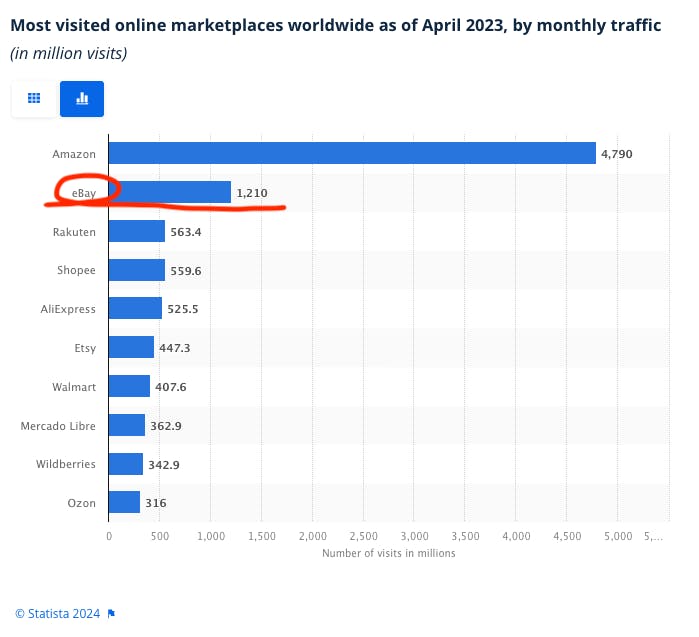
Despite the company’s global dominance, there are a lot of opportunities for smaller, niche marketplaces to enter and thrive. In this guide, we’ll walk you through the process of building a website like eBay, from identifying an idea to launching your first MVP.
Online marketplaces have become one of the fastest-expanding business models today.
In 2023 alone, online marketplaces accounted for over one-third of global online shopping orders.
And the growth isn’t slowing down. Predictions show that by 2027, third-party sales on online marketplaces will be the largest and fastest-growing retail channel worldwide.
This growth opens the door for increased competition, particularly from smaller, more agile marketplaces that focus on specific niches or geographic markets. If you’ve ever wanted to build a marketplace like eBay, now is a good time to start.
Interestingly, creating a marketplace platform like eBay has gotten a lot easier, with less team and budget required. Here’s why:
- No inventory needed: You don't need to hold or manage any inventory yourself. Instead, you connect buyers with third-party sellers, who list their items for sale on the platform.
- Low barrier to entry: Today’s marketplace builders have made launching an online marketplace faster, easier, and more cost-effective than ever. For instance, tools like Sharetribe's no-code marketplace builder let you launch a fully functional marketplace website within a day—without writing any code.
- Test and iterate easily: Since you can launch your website within a day, you can test your business idea, get user feedback, and iterate on your model before investing heavily.
In short, creating a successful online marketplace is now more achievable than when eBay started. This guide shows you the best practices for developing a platform like eBay.
eBay operates as a digital auction house and marketplace. They connect buyers or bidders to sellers.
Sellers on eBay list items with the option to set a fixed price or allow buyers to bid in an auction format. They have a dashboard with tools to manage their listings, track sales, and interact with buyers.
For customers, eBay offers a user-friendly interface where they can easily search for items, place bids, and make purchases. Buyers can watch items, receive notifications on auction progress, communicate directly with sellers, and leave feedback after transactions.
eBay also provides buyer protection programs to ensure that buyers receive their items as described or can get their money back in case of discrepancies.
When it comes to payment, eBay marketplace offers various payment methods through its integrated payment system, usually PayPal. (For a long time, PayPal was the only payment option on eBay; eBay acquired PayPal in 2002, and the companies separated in 2015.) The platform also handles disputes and provides customer support when needed.
eBay generates its revenue primarily through transaction fees (“final value fees” and listing fees (“insertion fees”) on each item. Up to 250 listings per month are free of insertion fees. The transaction fees depend on the product category.
Also, sellers have the chance to pay promotional listing fees to highlight their listings and attract more buyers.
Unlike Amazon, which operates both as a retailer and a marketplace, eBay operates as an auction format and peer-to-peer transactions (C2C).
eBay is currently the second most popular online marketplace among sellers in the US, followed by Etsy.
Pierre Omidyar created eBay in 1995 as a hobby project that he incorporated into his personal site, which he initially named AuctionWeb.
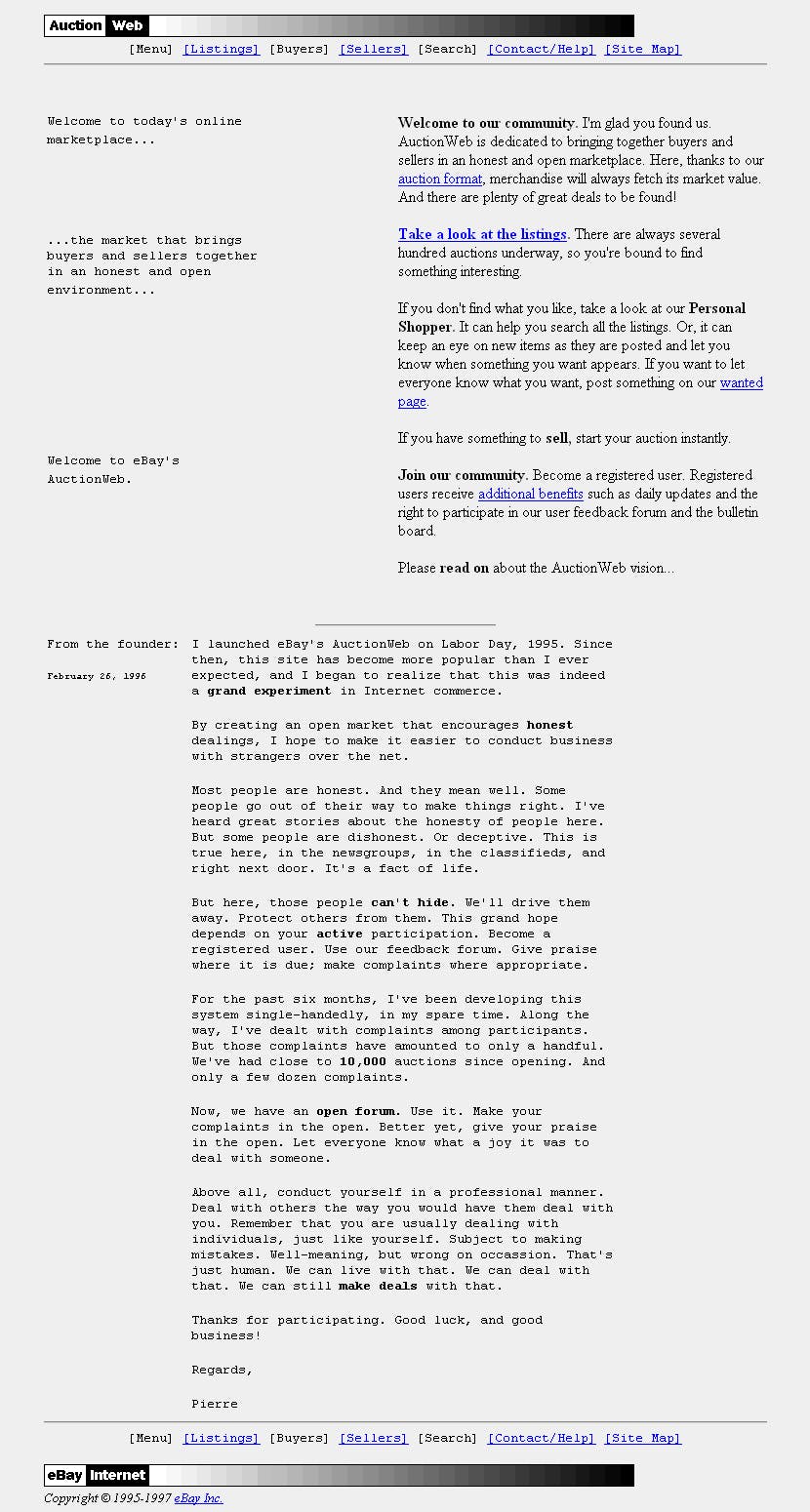
Omidyar listed a few second-hand items for sale on the website. Famously, the first item sold was a broken laser pointer for $13.83. AuctionWeb quickly became known as a platform for selling collectibles and unique items through auctions. The company changed its name from AuctionWeb to eBay in September 1997.
A key moment for eBay's growth was the rise of the Beanie Babies craze in the 1990s. Collectors flocked to the platform to buy, sell, and trade these popular plush toys, driving huge transaction volume.
Over the years, what was initially a hobby project has evolved into an online multi-seller auction marketplace that acquired 73 other companies, such as Certilogo, Milo, and Paypal. Today, eBay remains a popular platform for buying and selling various goods.
So, why did eBay succeed? Here are some success tips you can learn from eBay when building your own business:
- Focus on a specific niche: eBay's early success was driven by its focus on serving the collectibles and hobbyist market. Identifying and focusing on a niche and serving it well is the approach we’ve seen work time and time again at Sharetribe as we’ve worked with successful marketplace founders for over a decade.
- Offer a differentiated value proposition: eBay carved out a unique position as an auction-focused marketplace with relatively low selling fees compared to traditional retail channels. Finding a differentiated angle can help you stand out in a crowded market.
- Leverage emerging trends: eBay capitalized on the rising popularity of Beanie Babies. This approach ensures you meet consumer needs and position your business to benefit from them.
- Prioritize the user experience: eBay's platform made it easy for individual sellers and collectors to list, buy, and trade items.
- Start small, test, and iterate: eBay started as a simple online auction site and gradually expanded its offerings. This approach of testing and iterating based on user feedback explains refine your idea or model before scaling.
This article takes lessons from eBay's success and provides you with 10 actionable steps to help you create a thriving and scalable business like eBay.
So, let’s dive straight in.
At Sharetribe, we’ve helped hundreds of people start their own marketplaces. From our experience, the process of building a marketplace like eBay follows 10 steps:
- Identify a strong marketplace idea.
- Choose the right marketplace business model.
- Start with a focused scope.
- Pre-validate your marketplace idea.
- Build a marketplace platform, starting with an MVP (Minimum Viable Platform).
- Onboard your first sellers.
- Launch your marketplace.
- Reach problem-solution fit.
- Reach product-market fit.
- Scale into new markets.
Next, we’ll discuss these 10 steps specifically in the context of building a website like eBay.
For more details and additional resources, check out our definitive guide on creating a marketplace.
The first step in identifying a marketplace idea similar to eBay is to look into verticals or product categories currently underserved on the eBay platform.
eBay users' pain points and frustrations can help you identify opportunities to build a more compelling alternative. For example, some users complain about having bad experiences in niches like electronics and deliveries in the eBay community.
For example, a user posted this in the eBay community:
“Is there a good demand for handmade crafts and decorations? My mother is very talented in craft making. So I thought to sell them online.”
One notable answer was: “Being that you're located in Sri Lanka, there are quite a few hurdles that you will have to overcome before being allowed to sell on eBay.”
That discussion could already point to a niche (handmade crafts and decorations) and a problem (lack of support for the Sri Lankan market) you could start digging deeper into.
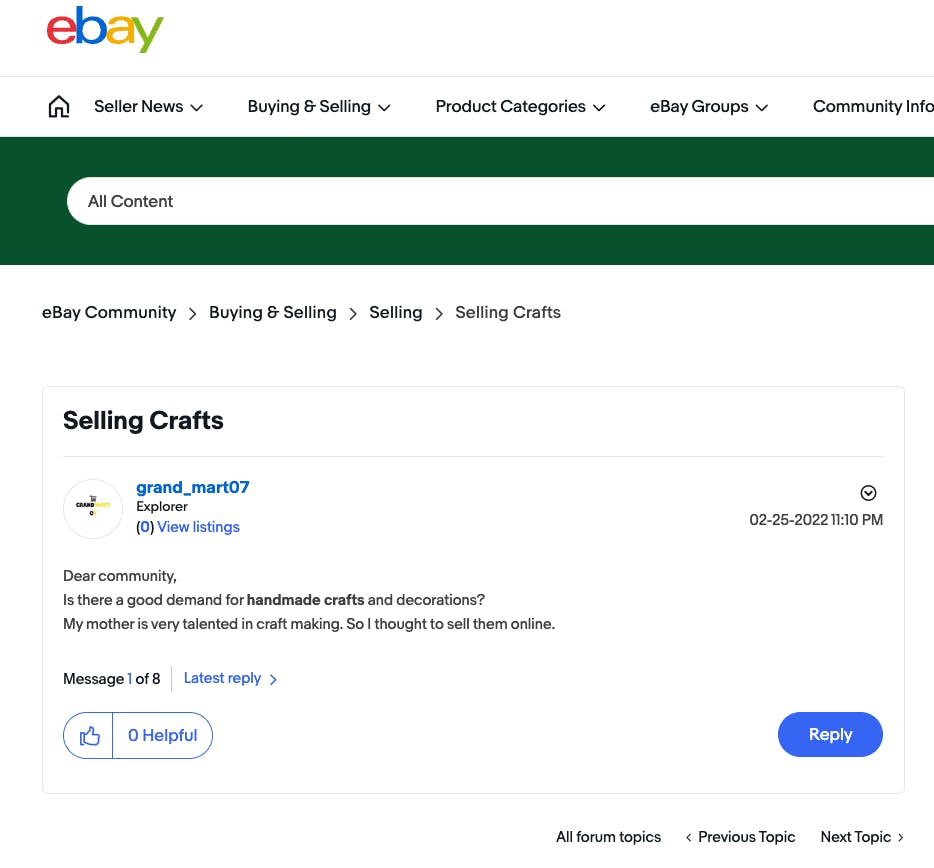
Your niche could also be areas where you have deep personal expertise, experience, and insights, but it must resonate with users.
Focusing on such verticals that you can improve can help you tap into an existing user base and marketplace demand while differentiating your offering and providing a superior experience.
Generally, there are six different types of business models that marketplaces use to make money:
- Commission
- Subscription
- Listing fees
- Lead fees
- Freemium models
- Featured listings.
The commission-based model is the most popular revenue model among marketplaces. eBay's primary revenue model is a combination of commissions and listing fee.
Here’s how it works: When a sale is made, eBay charges a commission based on the final sale price, called the "Final Value Fee." This fee ranges from 3% to 15% of the total sale amount depending on the category of a product. There’s also a per-order fee of an additional $0.30 or $0.40 per order. It is higher for more expensive items and lower for less expensive items.
In addition, eBay charges sellers fees for listing items on their platform. The fee varies depending on the listing type (auction or fixed-price), the item's category, and other factors. Generally, eBay lets sellers list 250 items for free monthly. After reaching the limit, the platform charges an insertion fee of $0.35 for each listing.
Over time, eBay has added featured fees through its marketing services, such as sponsored listings and other advertising options. However, the company initially started with a commission model before expanding its options.
When starting a business, we advise Sharetribe clients to focus on the value proposition and avoid setting too many fees upfront. We recommend only considering expanding revenue streams after achieving product-market fit.
You might be tempted to go big at once. After all, the goal is to build a website like eBay. However, resist the temptation to try to be all things to everyone from the outset.
When eBay launched in 1995, it was a simple website that connected buyers and sellers in an honest and open marketplace for auctions and collectibles. In fact, eBay's founder, Pierre Omidyar, was the first seller to list his broken laser printer for $1, but no one showed interest for one week.
Gradually, bidders started showing up, and the printer price went up to $14.83. That's when Omidyar knew he was on to something big.
From there, eBay established a foothold, built trust with its early users, and perfected the core marketplace experience.
After this initial success, the company gradually expanded its offerings to include online auctions for travel-related products such as airline seats, hotel rooms, and cruise berths. With this crawl-walk-run approach, eBay grew thoughtfully and sustainably rather than spreading itself too thin too fast.
This gradual expansion strategy is a best practice we've seen work time and time again with the marketplace founders we've supported at Sharetribe.
When planning your marketplace, you’ve made some assumptions about:
- Problems you think sellers and buyers have
- Solutions you have to the problem
- Plans to monetize solving the problem (your business model).
However, before investing significant time and resources into building a marketplace like eBay, you must test these assumptions to ensure they’re true.
One good way is to find and talk to your target audience in person and online. You can also ask questions about your target market in online forums, communities, and social media groups.
Ask if people have the problem you assume they have – and how they’re solving it now. Then, pitch a prototype of your idea and listen to their feedback.
On the other hand, if the feedback shows some of your assumptions were wrong, change your approach and validate again!
The early versions of eBay were hardly feature-rich or visually stunning, but they allowed Omidyar to test his idea.
The website had a simple user interface that lets users perform basic things like:
- See the catalog of auction items.
- Let users bid on the products they want to win and make payments.
Similarly, your marketplace MVP should offer essential value propositions and transaction features without fancy extras. But, ensure it doesn't have a very poor UI that drives users away from day one.
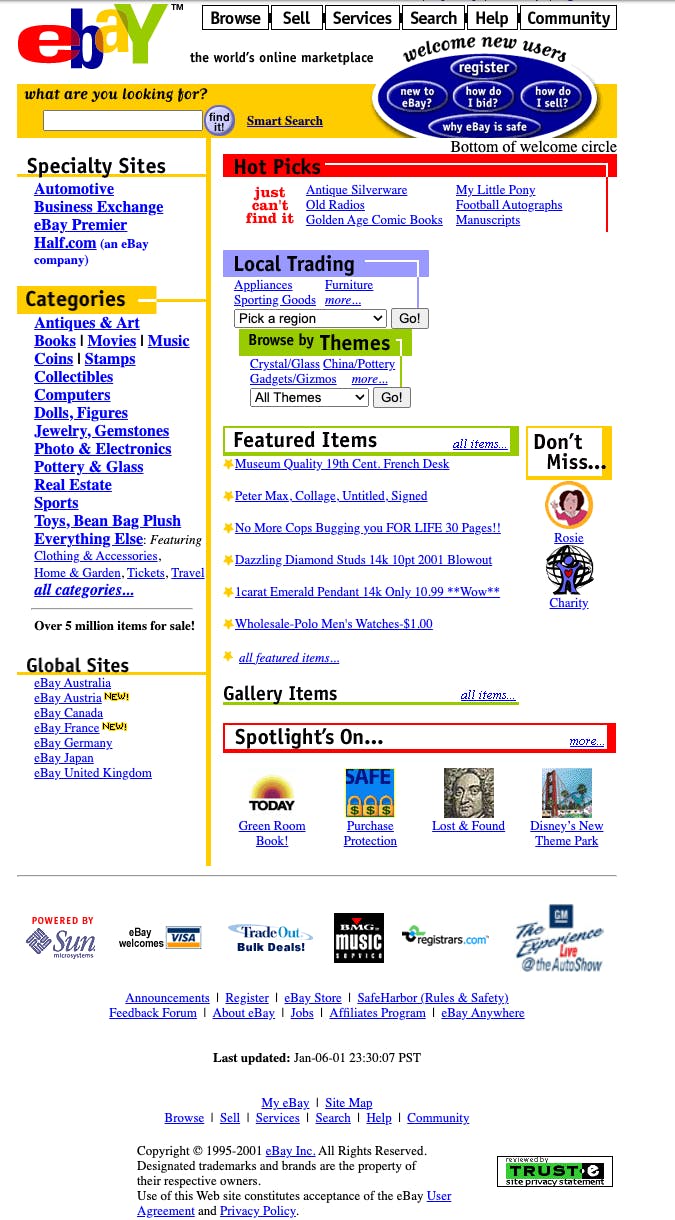
If you're not tech-savvy, you have three options for creating an MVP like eBay.
- Hire a freelancer or agency to develop it for you.
- Find a technical co-founder to create it for free.
- Use no-code tools to build the MVP yourself.
If you’re looking for a faster, more efficient method, the last option could be your best bet. Sharetribe, for instance, lets you build and launch a fully functional marketplace in a few days without any coding required (it doesn’t have a pre-built auction feature, but you could start with fixed pricing that’s available out of the box and add a custom-coded auction flow once you’ve gotten some traction). As a result, you can:
- Launch your first version much faster
- Collect insights from real customers
- Test and implement new features quickly and efficiently
- Save resources and focus on what matters
- Adapt based on user feedback
The key idea at this stage is to launch essential features as an MVP and gather feedback to determine what to enhance, modify, or develop next based on real user behaviors.
One major consideration for your MVP is whether you need a multi-vendor shopping cart functionality. This feature lets customers add products from multiple sellers on a marketplace website or mobile app to a single cart and purchase them all at once.
eBay offers a multi-vendor shopping cart feature. For example, you could buy some extension cords, a vintage dress, and a birdhouse with a single checkout.
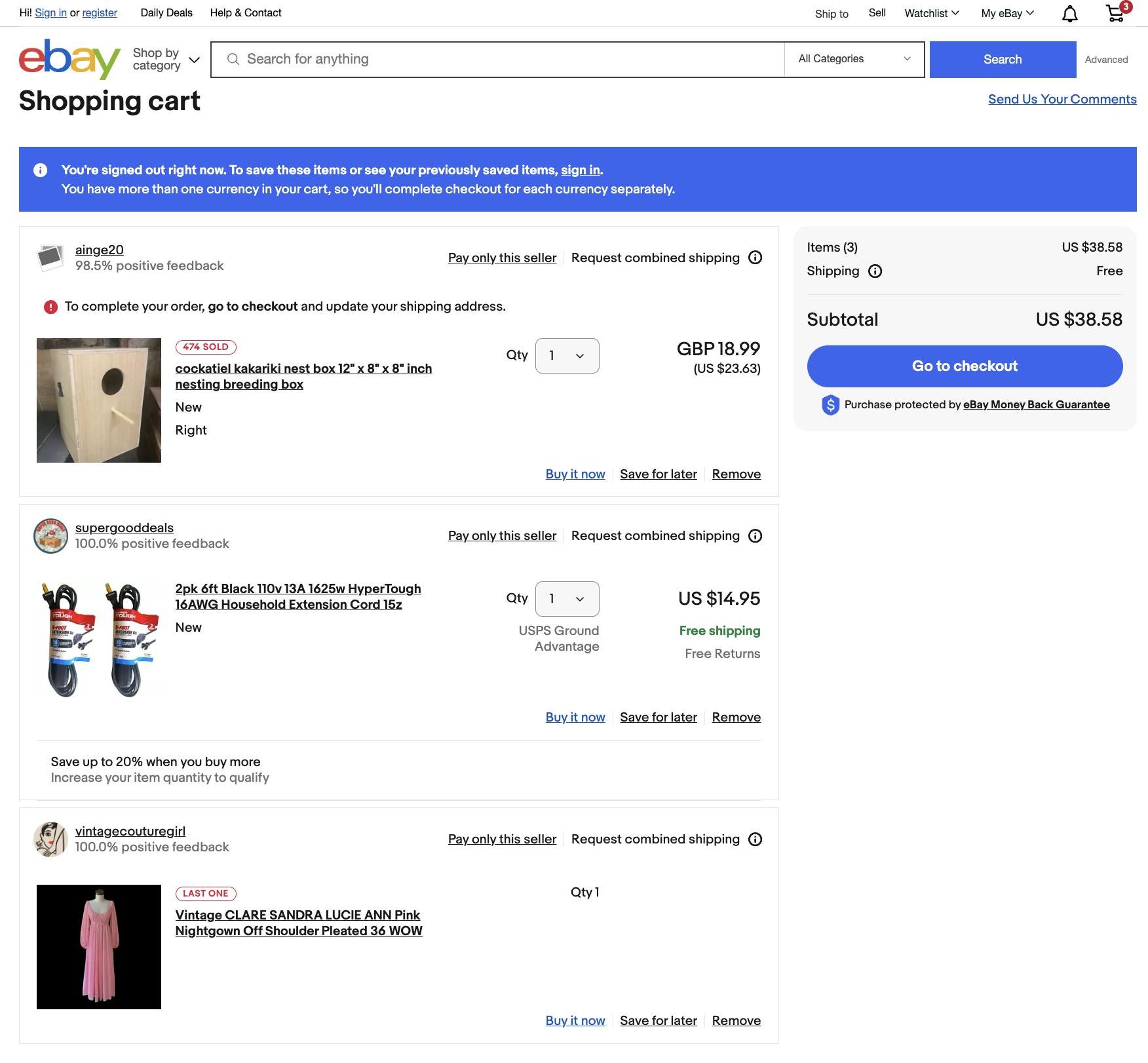
Not every marketplace will need this feature. Even if you expect a shopper to order from multiple vendors in a single session, a cart is not the best option in this case.
For example, fashion marketplaces like Vinted and Poshmark don’t have multi-vendor shopping carts. Customers click a quick “buy now” button to make a purchase, and if they wish to buy several items, they make separate orders. When the payment flow is fast the friction is low, and the risk of abandoned carts that plagues eCommerce is avoided.
In contrast, online marketplaces like eBay and Amazon let buyers buy products from multiple sellers in one session. These marketplaces need a multi-vendor shopping cart to facilitate this type of shopping. This way, customers don't have to enter their credit card information, shipping address, and other details for each purchased item.
Sharetribe doesn’t offer a multi-vendor shopping cart feature out of the box, but it’s possible to add one through custom code.
If you’re not sure yet whether to add one to your marketplace, read our guide on building a multi-vendor shopping cart. It provides more context to help you make a decision.
Your MVP is ready for its first users, but how do you attract sellers without customers and buyers without sellers? This is the common chicken-and-egg problem marketplaces face at their initial level.
eBay’s approach here was arguably not very strategic: the founder placed his broken laser printer for auction, and that invited buyers. The lesson, however, stands: usually, it’s best to start by building a great supply.
Without a strong seller base, you won't have the inventory and selection to attract buyers to your platform.
There are many ways to find and build marketplace supply:
- Like eBay founder Pierre Omidyar, become a supplier yourself.
- Visit local meetups and events.
- Find sellers in online forums and groups.
- Reach out to them in person.
- Fake initial supply (scrape listings from the web or find the listing your customer booked manually).
If you've become active in online communities related to your marketplace focus, you might have a good starting point for onboarding sellers who are already frustrated with the limitations of eBay or other existing options.
All you have to do is show how your marketplace can provide a superior seller experience compared to eBay.
Some of the ways to convince early supply to join before you have any customers:
- Offer lower fees and commissions than eBay.
- Offer discounts or deals to early adopters.
- Communicate buyers' potential (more targeted exposure to the right buyer audience).
- Show sellers opportunities to build their brand and customer relationships.
- Supply better tools and features to manage their listings and inventory. (“Why is eBay so complicated?” and “Absurdly complicated!” are just a few examples of frustrated community discussions around eBay’s complexity.)
In short, attract a community of sellers to list their products on your platform, and buyers will come.
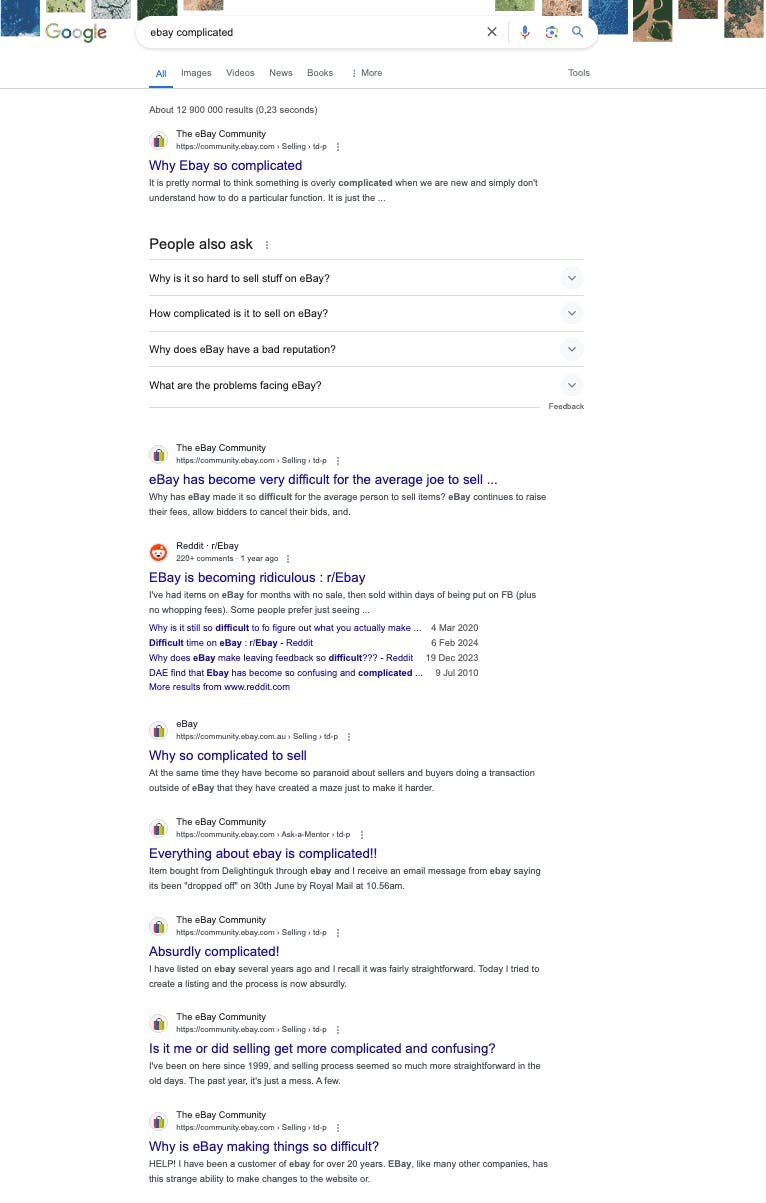
This is the phase where you bring your first sellers some buyers.Your initial launch should be to a carefully selected beta audience rather than a broad public debut.
This way, you can test your platform, gather crucial feedback from real users, and make necessary adjustments before a wider rollout.
The faster you launch, the sooner you'll know if your eBay-inspired marketplace has real potential.
Here are a few ideas for finding your first customers.
- Turn to your sellers. If they’ve been active on marketplaces like eBay before, they may have their own buyer acquisition channels.
- Look for active online forums, Facebook groups, or subreddits relevant to your marketplace's niche.
- Visit local events, clubs, or meetups where your target audience might gather.
- Run a small paid search campaign to attract interested users.
If you can convince buyers that your platform offers better value (that is: better-quality supply) than others, you have a solid vaue propostion.
Having both buyers and sellers on board is a significant milestone, but it's just the beginning. Now comes the crucial stage for problem-solution fit.
Reaching a problem-solution fit means your platform effectively solves your buyers' and sellers' pain points and unmet needs.
In other words, at this stage, your marketplace:
- Consistently facilitates successful transactions.
- Generates revenue potential (not necessarily profits, but promising signs).
However, sometimes, despite having several users on your platform, you may not see signs of a problem-solution yet—no transactions.
But don’t worry—you just need to iterate and make some changes. A good way to start is by contacting your users and asking them what's wrong:
- Did they understand the purpose of your website? If not, consider how you present your value proposition.
- Did you have what buyers were interested in, or do you need to expand your pool of suppliers?
- Did they have trouble finding what they were looking for, it may be necessary to rethink your matching process.
Alternatively, if you have many abandoned transactions or shopping carts, you can redesign your transaction flow or consider adjusting your pricing. Perhaps a “buy now” button without a multi-vendor shopping cart would work better?
However, resist the temptation to start scaling too quickly at this stage, even if your ultimate goal is eBay-like success. This phase is all about ensuring you've nailed the core functionality and user experience before attempting to scale.
eBay itself went through experimentation, iteration, and data-driven customer insights before achieving its dominant market position.
In reality, most marketplaces don't erupt into overnight sensations, so don’t be discouraged by initial poor traction. Instead, see this as a chance to spotlight the features and channels that are truly resonating with your users.
A product-market fit occurs when there is a clear demand for what you're offering, users are actively engaging with and benefiting from your platform, and you’re profiting.
If you’re building a large-scale marketplace like eBay, you’ll likely need some external marketplace funding. This is the stage where you should really focus on creating a solid playbook for scaling and expanding into new markets.
eBay's path to success was quite a relatively quick one. In early 1996 (a year after it launched), eBay grew to become a million-dollar business. The company then received $6.7 million in funding from Benchmark Capital, a venture capital firm, before going public in 1998 with a share price of $18.
However, the current VC process and investor expectations are similar to eBay's quick profitability. Modern investors are focusing much harder on profitability and sustainable growth metrics.
Therefore, reaching a strong product-market fit and having a clear, data-driven playbook for replicating that success in new markets will be critical when seeking external funding for your large-scale marketplace.
So, how do you know if you've hit product-market fit? Here are some key metrics to keep an eye on:
- Liquidity (the likelihood of a transaction on your marketplace.
- Repeat-purchase rate
- Unit economics (customer acquisition costs vs. customer lifetime value)
- GMV retention
Of these metrics, liquidity is arguably the most important.
To boost consistent liquidity, you must build a scalable growth system for your marketplace.
Some effective strategies for scalable growth systems include:
- Marketplace SEO: Optimize your platform's content and discoverability to attract organic traffic.
- Viral marketing or network effects: Implement features that incentivize users to invite their networks.
- Direct outreach: Proactively recruit and onboard both buyers and sellers.
- Hyperlocal offline marketing: Engage with your community through events, partnerships, and offline channels.
At this stage, your simple MVP may no longer be sufficient. You'll likely need to invest in product development to improve functionality, user experience, and other differentiating features.
If a platform like Sharetribe powers your marketplace, adding custom-coded elements on top of the no-code builder can be an effective approach.
After achieving product-market fit on auctions and collectibles, eBay gradually expanded its scope in the early 2000s to include new categories such as electronics, fashion, and even vehicles. A response to consumer demands and market trends.
This attracted a broader customer base and solidified its market standing as a comprehensive retail platform.
On the geographic expansion front, eBay took a similar incremental approach. After launching sites in Germany, Australia, and the U.K. in 1999, eBay is now available in 180 countries.
The key principle is incrementally applying your product-market fit playbook to new categories and territories. Three ways your marketplace can scale are:
- Add new categories or products that complement your existing offerings
- Expand into a new location.
- Reach new customer demographics.
Your goal is to maximize the value of your existing marketplace infrastructure, processes, and expertise acquired during the initial product-market fit stage.
When scaling into new markets, ensure you practice the following:
- Scale one market at a time.
- Reach product/market fit in that market.
- Create a playbook of what works.
- Repeat the process until your business goals are met.
In a nutshell, conduct thorough market research before entering a new market. This will help you understand how the new market differs from your current one. Once you have this information, you can establish your presence in the new market with your playbook.
Building a marketplace website has become easier and more accessible, especially with no-code solutions that allow you to launch an MVP quickly.
For emphasis, the key steps to building a successful eBay-like marketplace include:
- Identify a strong niche idea like eBay and choose the suitable business model for it
- Start with a focused scope
- Pre-validate your idea, then build your MVP first.
- Attract your first sellers with incentives and then launch your marketplace
- Reach problem-solution fit
- Achieve product-market fit and codify your processes into a proven, repeatable playbook for expansion into new markets
- Then, scale into new markets.
Overall, start small, experiment, and let your customers be your guide. In time, you can grow your platform into a dominant force in your chosen industry, just as eBay has done.
The opportunity is there, and the tools and resources are available. Now, it's up to you to execute and build the next great online marketplace.
Start your 14-day free trial
Create a marketplace today!
- Launch quickly, without coding
- Extend infinitely
- Scale to any size
No credit card required
